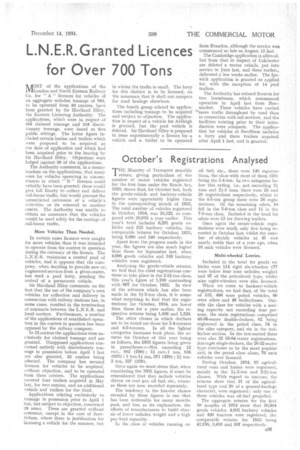October's Registrations Analysed
Page 91

If you've noticed an error in this article please click here to report it so we can fix it.
THE Ministry of Transport monthly return, giving particulars of the number of motor vehicles registered for the first time under the Roads Act, 1920, shows that, for October last, both the goods-vehicle and . hackney-vehicle figures were appreciably higher than in the corresponding inorith of 1933. The total number of vehicles registered in October, 1934, was 28,322, as compared with 20,916 a year earlier. This year's total includes 6,291 goods vehicles and 515 hackney vehicles, the comparable 'returns for October, 1933, being 5,080 and 240 respectively.
Apart from the progress made in the year, the figures are also much higher than -those for September last, when 4,996 goods vehicles and 348 hackney vehicles were registered.
Analysing the goods-vehicle returns, we find that the chief registrations continue to take place in the 2-2a-ton class, this year's figure of 1,708 contrasting with 997 for October, 1933. In view of the advance which has also been made in the 1I-2-ton class, it is somewhat surprising to find that the registrations for October, 1934, are lower than those for a year earlier, the respective returns being 1,436 and 1,528.
The other classes in which declines are to be noted are those for 3-4-jounces and 4-5-tonners. In all the lighter categories increases took place, the returns for October of this year being as follows, the 1933 figures being given in parentheses :—Not exceeding 12 Cwt., 882 (760) ; 12 cwt.-1 ton, 838 (628). ; 1 ton-1a ton, 571 (470) ; 2a ton3 too, 327 (259).
Once again we must stress that, when considering the 1933 figures, it must be remembered that they include vehicles driven on coal gas, oil fuel, etc., whereas these are now recorded separately.
The tendency in the heavier classes revealed by these figures is one that has been noticeable for many months past, and has, as its explanation, the efforts of manufacturers to build chassis of lower unladen weight and a high pay-load capacity.
In the class of vehicles running on oil fuel, etc., there were 148 registrations, the class with most of them (88) being the 3-4-ton. In two categories below this rating, i.e., not exceeding 2} tons and 2i-3 tons, there were 28 and 20 registrations respectively, whilst in the 4-5-ton group there were 26 registrations. Of the remaining oilers, 1(3 fell in the 5-6-ton class and 11 in the 7-8-ton class. Included in the total for oilers were 13 for drawing trailers.
Once again the steam-vehicle registrations were small, only five being recorded in October last, whilst the 'number of electric vehicles at 45 was nearly treble that of a year ago, when 16 such vehicles were licensed.
Multi-wheeled Lorries.
Included in the total for goods vehicles were 114 rigid six-wheelers (77 were below four tons unladen weight) and 67 of the articulated type, whilst nine eight-wheelers were also licensed.
When we come to hackney-vehicle registrations, we find that, of the total of 515, 406 were petrol vehicles, 60
• were oilers and 49 trolleybuses. Outside the class for vehicles with a seating capacity not exceeding four persons, the main registrations comprised 48-56-seater double-deckers, 82 being registered in the petrol class, 34 in -the oiler category, and six in the trolleybus section. In the last-named there were also 32 56-64-seater. registrations. Amang,st single-deckers, the 26-32-seater type continues to be -the most popular and, in the petrol class alone, 76 such vehicles were licensed.
During October, 1934, 83 agricultural vans and lorries were registered, mainly in the 11-2-ton and 2-2a-ton classes. With regard to tractors. the returns show that 21 of the agricultural type and 28 of a general-haulage character, were registered ; only one of these vehicles was oil-fuel propelled.
The aggregate returns for the first 10 mouths of 1934 shoWthat 56,984 goods vehicles. 4,602 hackney vehicles and 420 tractors were registered. the comparable returns for 1933 being 43,168, 3,416 and 307 respectively.




































































































































































